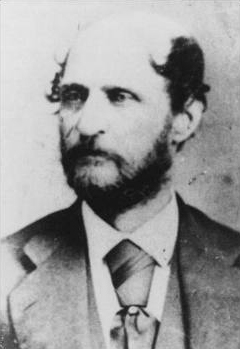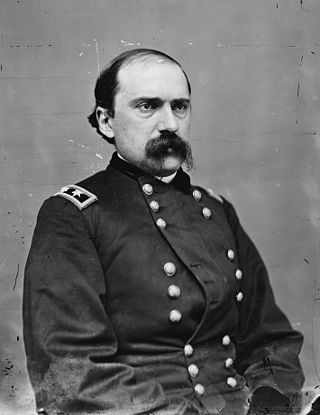
Nathan Bedford Forrest was a Confederate Army general during the American Civil War and was later the first Grand Wizard of the Ku Klux Klan from 1867 to 1869.

Selma is a city in and the county seat of Dallas County, in the Black Belt region of south central Alabama and extending to the west. Located on the banks of the Alabama River, the city has a population of 17,971 as of the 2020 census. About 80% of the population is African-American.

Darien is a city in and the county seat of McIntosh County, Georgia, United States. It lies on Georgia's coast at the mouth of the Altamaha River, approximately 50 miles south of Savannah, and is part of the Brunswick, Georgia metropolitan statistical area. It is the second-oldest planned city in Georgia and was originally called New Inverness. The population of Darien was 1,460 at the 2020 census, down from 1,975 in 2010.

Quantrill's Raiders were the best-known of the pro-Confederate partisan guerrillas who fought in the American Civil War. Their leader was William Quantrill and they included Jesse James and his brother Frank.

The Battle of Nashville was a two-day battle in the Franklin-Nashville Campaign that represented the end of large-scale fighting west of the coastal states in the American Civil War. It was fought at Nashville, Tennessee, on December 15–16, 1864, between the Confederate Army of Tennessee under Lieutenant General John Bell Hood and the Union Army of the Cumberland (AoC) under Major General George H. Thomas. In one of the largest victories achieved by the Union Army during the war, Thomas attacked and routed Hood's army, largely destroying it as an effective fighting force.

James Harrison Wilson was a United States Army topographic engineer and a Union Army Major General in the American Civil War. He served as an aide to Maj. Gen. George B. McClellan during the Maryland Campaign before joining Maj. Gen. Ulysses S. Grant's army in the Western Theater, where he was promoted to brigadier general. In 1864, he transferred from engineering to the cavalry, where he displayed notable leadership in many engagements of the Overland Campaign, though his attempt to destroy Lee’s supply lines failed when he was routed by a much smaller force of Confederate irregulars.

The Battle of Selma was fought on April 2, 1865 in Dallas County, Alabama during the American Civil War. It was part of the Union campaign through Alabama and Georgia, known as Wilson's Raid, in the final full month of the Civil War.

Two corps of the Union Army were called Cavalry Corps during the American Civil War. One served with the Army of the Potomac; the other served in the various armies of the western theater of the war.

The Franklin–Nashville campaign, also known as Hood's Tennessee campaign, was a series of battles in the Western Theater, conducted from September 18 to December 27, 1864, in Alabama, Tennessee, and northwestern Georgia during the American Civil War.
The Battle of West Point, Georgia, formed part of the Union campaign through Alabama and Georgia, known as Wilson's Raid, in the final full month of the American Civil War.

Birkett Davenport Fry was an adventurer, soldier, lawyer, cotton manufacturer, and a Confederate brigadier general in the American Civil War. A survivor of four battle wounds, he commanded one of the lead brigades during Pickett's Charge at the Battle of Gettysburg.

Edward Moody McCook was a lawyer, politician, distinguished Union cavalry general in the American Civil War, American diplomat, and governor of the territory of Colorado. He was a member of the famed "Fighting McCook" family of Ohio. Four of his brothers and 10 of his first cousins served as officers, with six of the family members becoming generals before the end of the war.
Wilson's Raid was a cavalry operation through Alabama and Georgia in March–April 1865, late in the American Civil War. U.S. Brig. Gen. James H. Wilson led his U.S. Cavalry Corps to destroy Confederate manufacturing facilities and was opposed unsuccessfully by a much smaller force under Confederate Lt. Gen. Nathan Bedford Forrest.

Alabama was central to the Civil War, with the secession convention at Montgomery, the birthplace of the Confederacy, inviting other slaveholding states to form a southern republic, during January–March 1861, and to develop new state constitutions. The 1861 Alabaman constitution granted citizenship to current U.S. residents, but prohibited import duties (tariffs) on foreign goods, limited a standing military, and as a final issue, opposed emancipation by any nation, but urged protection of African-American slaves with trials by jury, and reserved the power to regulate or prohibit the African slave trade. The secession convention invited all slaveholding states to secede, but only 7 Cotton States of the Lower South formed the Confederacy with Alabama, while the majority of slave states were in the Union. Congress had voted to protect the institution of slavery by passing the Corwin Amendment on March 4, 1861, but it was never ratified.

Francis Crawford Armstrong was a United States Army cavalry officer and later a brigadier general in the Confederate States Army during the American Civil War. He is also known for being the only Confederate general to fight on both sides during the Civil War.
Selma, Alabama, during the American Civil War was one of the South's main military manufacturing centers, producing tons of supplies and munitions, and turning out Confederate warships. The Selma Ordnance and Naval Foundry complex included a naval foundry, shipyard, army arsenal, and gunpowder works. Following the Battle of Selma, Union Maj. Gen. James H. Wilson's troops destroyed Selma's army arsenal and factories, as well as much of the city.
Plantersville is an unincorporated community in Dallas County, Alabama, United States. It lies near the county's border with Autauga and Chilton counties. Plantersville was named for the local cotton planters and plantations. The town is home to Dallas County High School and J. E. Terry Elementary School.

Forrest's Cavalry Corps was part of the Confederate States Army during the American Civil War and commanded by Lieutenant General Nathan Bedford Forrest. Formed during the summer of 1862, it took part in the various battles in the Western Theater during the second half of the war. At first serving as part of the Army of Tennessee, both Forrest and the corps were then transferred to northern Mississippi and often launched independent raids into Union occupied western and central Tennessee.
The Battle of Columbus, Georgia, was the last conflict in the Union campaign through Alabama and Georgia, known as Wilson's Raid, in the final full month of the American Civil War.

Pickett's Mill Battlefield Site is a Georgia state park in Paulding County, Georgia, that preserves the American Civil War battlefield of the Battle of Pickett's Mill. The 765-acre site includes roads used by Union and Confederate troops, earthwork battlements, and an 1800s-era pioneer cabin. The area's ravine is a site where hundreds died. The park's visitor center includes exhibits and a film about the battle.

















